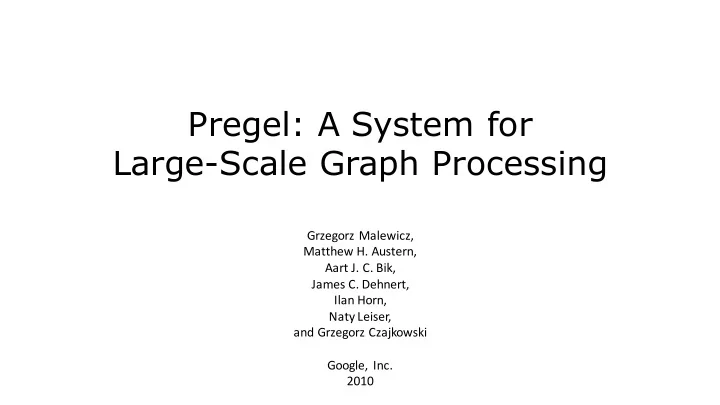

Pregel: A System for Large-Scale Graph Processing Grzegorz Malewicz, Matthew H. Austern, Aart J. C. Bik, James C. Dehnert, Ilan Horn, Naty Leiser, and Grzegorz Czajkowski Google, Inc. 2010
What is Pregel? • A System for Large-Scale Graph Processing. • An iterative and graph specific version of MapReduce. • A distributed implementation of the Bulk Synchronous Parallel model (BSP). • Efficient, scalable and fault-tolerant.
Graph Examples • Web Graphs. • Social networks. • Transport networks. • Similarity of newspaper articles. • Paths of disease outbreaks (epidemiology) • Citation relationships.
Algorithms • Maximum Value. • Shortest Path. • Clustering. • Variations of Page Rank. • Minimum Cut. • Connected Components.
Graph processing challenges • Poor locality of memory access. • Low compute to communication ratio. • Changing degree of parallelism over the course of execution.
Previous Options • Craft a custom distributed infrastructure. • Lots of effort. • Have to re-implement for each new algorithm or graph representation. • Use existing distributed computing platform such as MapReduce. • Can lead to sub-optimal performance and usability issues. • Better fit would be a message passing model. • Use graph algorithm libraries for use on a single machine. • Severely limits scale. • Use existing parallel graph system. • No fault tolerance or support for other distributed system problems.
Pregel’s solution • Implement a scalable and fault-tolerant platform with an API that is sufficiently flexible to express arbitrary graph algorithms. • Just like MapReduce, take care of all distributed problems behind the scenes. • Present simple functions to be filled in by the programmer. • Designed to be optimal for graphs.
Pregel Computation • One Master <-> Many workers. • Master synchronizes workers, each worker performing a computation in each Superstep . • Worker’s send messages between themselves. • Iterates until all vertices vote to halt a and there are no messages in transit.
Vertices • Has a modifiable value and a list of its outgoing edges and their values. • Only computes when active. • All perform the same function. • Receives all messages sent to it in the previous superstep. • Performs computation. • Sends messages (most likely along outgoing edges). • Optionally vote to halt. • Can request to add/remove vertices/edges.
Example: PageRank
Other Aspects • Message Passing • Delivered in asynchronous batches using buffer . • No order guarantees. • Combiners • Combines messages headed for destination. • No guarantee it will happen. • Aggregators • Master can aggregate data passed to it by workers. • Statistics, coordination, leader assignment. • Status Page
Other Aspects • Graph Partitioning • Uses default hash on ID. • Can be replaced to get better locality. • Fault tolerance • Check-pointing to persistent storage. • Failures detected using pings. • Frequency automatically calculated by mean time to failure model. • Confined recovery being looked into.
Performance • Tested using Single Source Shortest Path Algorithm and default partitioning hash. • Using binary tree and log-normal random graphs. • Gives linear runtime increase for increasing graph size for both. • Gives poorer performance for denser graphs.
Performance • For binary tree on fixed number of machines.
Criticism • Master is a single point of failure. • A lot of network communication, especially for dense graphs. • Still more limited (less expressive) than systems created later. • Hard to partition the graph in a way that takes advantage of locality. • Synchronicity slows all workers to the slowest worker. • No way to redistribute load between workers. • Performance not tested against any other systems or implementations.
Questions?
Recommend
More recommend